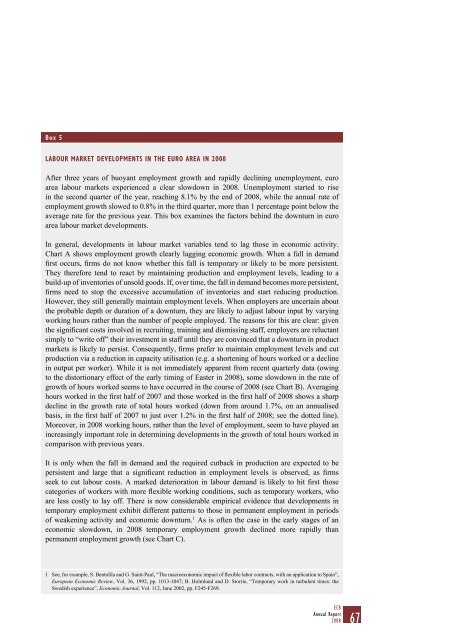ANNUAL REPORT 2008 - Polymer Bank Notes of the World
ANNUAL REPORT 2008 - Polymer Bank Notes of the World
ANNUAL REPORT 2008 - Polymer Bank Notes of the World
Create successful ePaper yourself
Turn your PDF publications into a flip-book with our unique Google optimized e-Paper software.
Box 5LABOUR MARKET DEVELOPMENTS IN THE EURO AREA IN <strong>2008</strong>After three years <strong>of</strong> buoyant employment growth and rapidly declining unemployment, euroarea labour markets experienced a clear slowdown in <strong>2008</strong>. Unemployment started to risein <strong>the</strong> second quarter <strong>of</strong> <strong>the</strong> year, reaching 8.1% by <strong>the</strong> end <strong>of</strong> <strong>2008</strong>, while <strong>the</strong> annual rate <strong>of</strong>employment growth slowed to 0.8% in <strong>the</strong> third quarter, more than 1 percentage point below <strong>the</strong>average rate for <strong>the</strong> previous year. This box examines <strong>the</strong> factors behind <strong>the</strong> downturn in euroarea labour market developments.In general, developments in labour market variables tend to lag those in economic activity.Chart A shows employment growth clearly lagging economic growth. When a fall in demandfirst occurs, firms do not know whe<strong>the</strong>r this fall is temporary or likely to be more persistent.They <strong>the</strong>refore tend to react by maintaining production and employment levels, leading to abuild-up <strong>of</strong> inventories <strong>of</strong> unsold goods. If, over time, <strong>the</strong> fall in demand becomes more persistent,firms need to stop <strong>the</strong> excessive accumulation <strong>of</strong> inventories and start reducing production.However, <strong>the</strong>y still generally maintain employment levels. When employers are uncertain about<strong>the</strong> probable depth or duration <strong>of</strong> a downturn, <strong>the</strong>y are likely to adjust labour input by varyingworking hours ra<strong>the</strong>r than <strong>the</strong> number <strong>of</strong> people employed. The reasons for this are clear: given<strong>the</strong> significant costs involved in recruiting, training and dismissing staff, employers are reluctantsimply to “write <strong>of</strong>f” <strong>the</strong>ir investment in staff until <strong>the</strong>y are convinced that a downturn in productmarkets is likely to persist. Consequently, firms prefer to maintain employment levels and cutproduction via a reduction in capacity utilisation (e.g. a shortening <strong>of</strong> hours worked or a declinein output per worker). While it is not immediately apparent from recent quarterly data (owingto <strong>the</strong> distortionary effect <strong>of</strong> <strong>the</strong> early timing <strong>of</strong> Easter in <strong>2008</strong>), some slowdown in <strong>the</strong> rate <strong>of</strong>growth <strong>of</strong> hours worked seems to have occurred in <strong>the</strong> course <strong>of</strong> <strong>2008</strong> (see Chart B). Averaginghours worked in <strong>the</strong> first half <strong>of</strong> 2007 and those worked in <strong>the</strong> first half <strong>of</strong> <strong>2008</strong> shows a sharpdecline in <strong>the</strong> growth rate <strong>of</strong> total hours worked (down from around 1.7%, on an annualisedbasis, in <strong>the</strong> first half <strong>of</strong> 2007 to just over 1.2% in <strong>the</strong> first half <strong>of</strong> <strong>2008</strong>; see <strong>the</strong> dotted line).Moreover, in <strong>2008</strong> working hours, ra<strong>the</strong>r than <strong>the</strong> level <strong>of</strong> employment, seem to have played anincreasingly important role in determining developments in <strong>the</strong> growth <strong>of</strong> total hours worked incomparison with previous years.It is only when <strong>the</strong> fall in demand and <strong>the</strong> required cutback in production are expected to bepersistent and large that a significant reduction in employment levels is observed, as firmsseek to cut labour costs. A marked deterioration in labour demand is likely to hit first thosecategories <strong>of</strong> workers with more flexible working conditions, such as temporary workers, whoare less costly to lay <strong>of</strong>f. There is now considerable empirical evidence that developments intemporary employment exhibit different patterns to those in permanent employment in periods<strong>of</strong> weakening activity and economic downturn. 1 As is <strong>of</strong>ten <strong>the</strong> case in <strong>the</strong> early stages <strong>of</strong> aneconomic slowdown, in <strong>2008</strong> temporary employment growth declined more rapidly thanpermanent employment growth (see Chart C).1 See, for example, S. Bentolila and G. Saint-Paul, “The macroeconomic impact <strong>of</strong> flexible labor contracts, with an application to Spain”,European Economic Review, Vol. 36, 1992, pp. 1013-1047; B. Holmlund and D. Storrie, “Temporary work in turbulent times: <strong>the</strong>Swedish experience”, Economic Journal, Vol. 112, June 2002, pp. F245-F269.ECBAnnual Report<strong>2008</strong>67




![KNOW YOUR NEW GIBRALTAR BANKNOTES - [Home] bThe/b](https://img.yumpu.com/50890985/1/184x260/know-your-new-gibraltar-banknotes-home-bthe-b.jpg?quality=85)
![PAPUA NEW GUINEA - [Home] - Polymer Bank Notes of the World](https://img.yumpu.com/49758743/1/190x143/papua-new-guinea-home-polymer-bank-notes-of-the-world.jpg?quality=85)










